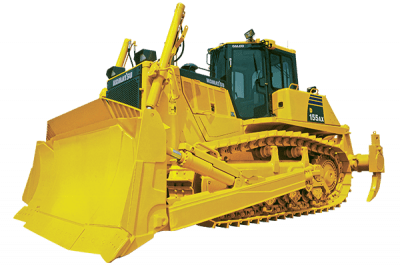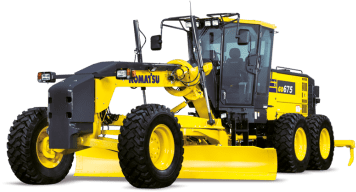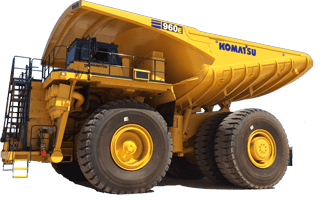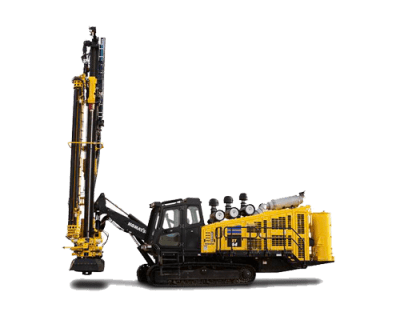News and media - press releases: Komatsu 960E-2KT drives Husab mining operation
Komatsu’s mechanical might is being harnessed in the development of Swakop Uranium’s massive Husab mine, arguably Namibia’s largest ever commercial undertaking. While the Komatsu fleet will total in excess of 50 products on completion of delivery, the most powerful and visually impressive will be its string of 23 960E-2KT electric dump trucks (EDT’s), some of which are already engaged in the development of the mine’s pit areas.
The 960E series is currently the largest off-road mining vehicle produced by Komatsu and despite its size, power output and payload capability, is outstandingly fuel efficient.
Komatsu’s long road to Husab began around five years ago, when the mine’s project team conducted a global survey of heavy duty mining equipment to identify which suppliers and products would be best suited to the operation’s needs.
Husab engineering and maintenance manager Jaco Duvenhage explains that during an exhaustive research and technical evaluation process, particular attention was paid to turnaround times - the key to the cost-effectiveness of an operation the size and scope of which will make it the world’s second-largest uranium mine.
"The development team realised at the outset that the right machinery for its purpose would deliver a combination of rapid cycle times and fuel efficiency while at the same time incurring low maintenance and running costs," says Komatsu South Africa manager mining business Frikkie Booyens.
Another given was the ability of the equipment to work in the intense heat of the Namib Desert, with temperatures reaching up to 40°C during the summer months.
What followed was a travel marathon involving several visits to Komatsu’s truck manufacturing headquarters in Peoria, Illinois, in the United States and mining sites around the world to see products in action at the sharp edge of the industry.
Trolley system
The quest to find the ideal EDT was accomplished when Komatsu presented its electric trolley system which delivers an alternative form of energy to propel trucks.
"The system was developed in conjunction with the Siemens Group and operates within the mining environment in basically the same way as an inner city commuter tramway,” says Booyens.
Trolley assist infrastructure comprising overhead cables, transformers and related equipment is established along the operation’s haul roads and transmits power to the truck via pantographs.
"This has the dual effect of increasing outright performance in terms of speed while decreasing the consumption of diesel by as much as 40% or more. The effect on cycle times is dramatic," he adds.
And it’s not difficult to see why.
At Husab, heavily laden haul trucks will wind their way from the bottom of the pit to the stockpile area over a difference in elevation in excess of 400 m. A fully laden truck packing an all-up weight of well over 500 metric tonnes is a very thirsty machine, but not so with the Siemens trolley option.
"Using electrical power on gradients will reduce a truck’s total fuel consumption by a factor of 40% or more. But what is hugely significant in terms of improved cycle times is that - by switching to trolley assist - trucks can haul at speeds of up to 26 km/h instead of 12 km/h in diesel mode."
The installation of the trolley system at Husab will be completed by 2017, when the mine is scheduled to be fully operational.
The might of the 960E-2KT
The 960E-2KT in use at Husab is visually impressive. The unit stands 9,3 m tall, is 15,3 m long and 10 m wide, making it hardly surprising that it will carry payloads of up to 327 metric tonnes from the pit.
Bulk is however deceptive as the truck bristles with a host of advanced features which ensure a high degree of tractability and maneuverability while, at the same time, providing a safe and comfortable working environment for the operator.
The heart of any truck is its power plant and the engine developed by Industrial Power Alliance, a joint venture between Komatsu and Cummins, does not disappoint, delivering a resounding 3 500 horsepower (hp) at 1 900 rpm.
Using technology to provide in-pit solutions
The mining environment is a challenging one as haul roads are often characterised by punishing gradients and tight turns which test the concentration and skills of operators. The 960E-KT, however, provides Husab with some very practical solutions to in-pit obstacles.
By using double-acting hydraulic steering cylinders with a six-point articulated linkage, the 960E-2KT power steering system provides steering control with minimal operator effort. In addition, the turning radius of the 960E-2KT is 16 m, which provides excellent maneuverability. These features not only facilitate seamless transition around tight corners but help avoid delays when the trucks operate in restricted loading and dumping conditions.
The cost effective operation of each of these mega vehicles is aided by the use of its built-in Payload Meter 111®, which helps to optimise payloads, deliver optimum performance and reduce the life cycle cost of these capital intensive machines. Data captured includes information related to payloads, carry back, haul cycle loading and dumping times, distances travelled and average and maximum speeds reached within designated time periods.
Effective control of a 580 tonne plus vehicle traversing steep gradients is of paramount importance, not only in ensuring operator safety but the safety of everyone working in the operational area. Continuous dynamic retarding capability rated at 6 196 hp helps the operator control the vehicle while travelling downhill, providing constant speed control.
Conversely, the Komatsu drive system is programmed with hill start logic to mitigate the risk of a roll back should the vehicle be stationary on a ramp. It also governs the truck’s braking function when the operator decides to continue their journey and employs traction control technology which automatically corrects wheel spin or lateral sliding motions in slippery or wet conditions. This operates independently from the vehicle’s main braking system.
Assembly and commissioning
The assembly and commissioning process started with the well-timed arrival of equipment from three continents to a 200m2 strip of sand some 65 kilometres from Swakopmund.
Bowsers, wheeled dozers, wheel loaders and graders were shipped from Japan direct to Walvis Bay located close to the project site, while the haul trucks made their way from Komatsu’s manufacturing facility in the United States.
The transportation of the trucks’ dump bodies, however, proved to be a more complex undertaking.
"To reduce freight costs these items were manufactured to Komatsu standards by a Johannesburg-based company; however, the original plan to ship them directly to Walvis Bay was thwarted because a short section of road from the docks to the assembly point was impassable owing to the sheer size of these units,” says Booyens. The final decision was to truck twenty-three 10-m-wide bowls 2 100 km from Johannesburg to Husab.
So far, eleven 960E-2KT’s have entered service at the mine and currently transport overburden from the operation’s two developing pits under diesel power. These pits are estimated to be around 2,5 km long and up to 1,3 km wide.
Operator training, skills transfer and evaluation is also being conducted using specially imported simulators, a clear indication of the sophisticated nature of the modern mining industry.
When ramped up to nameplate capacity, Husab will produce in excess of 150 million lb of uranium oxide a year.













